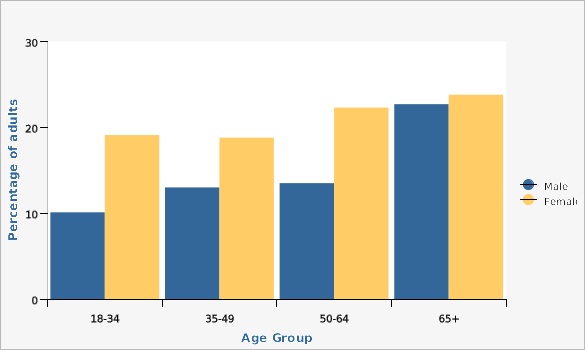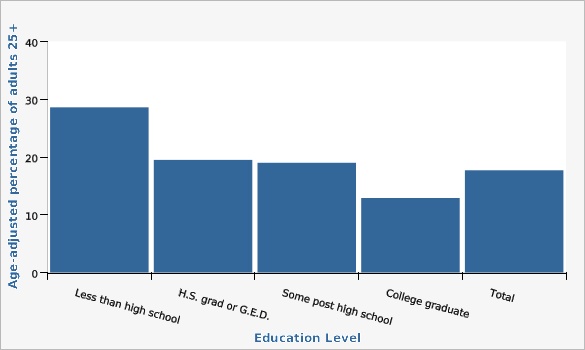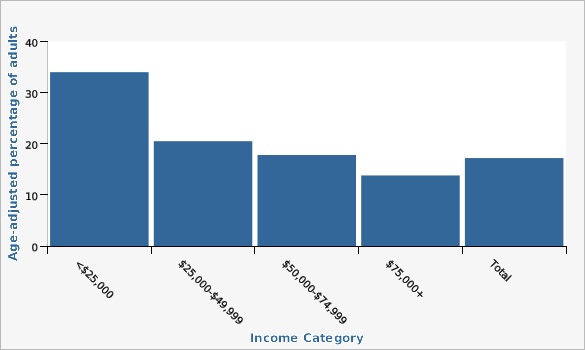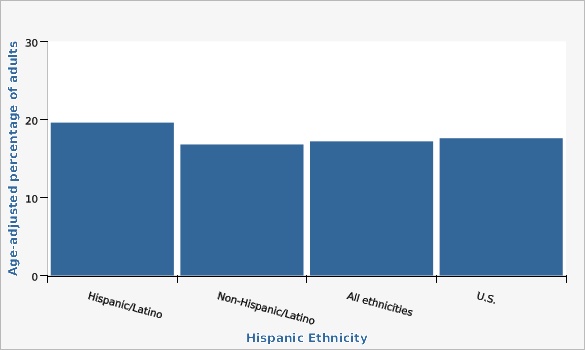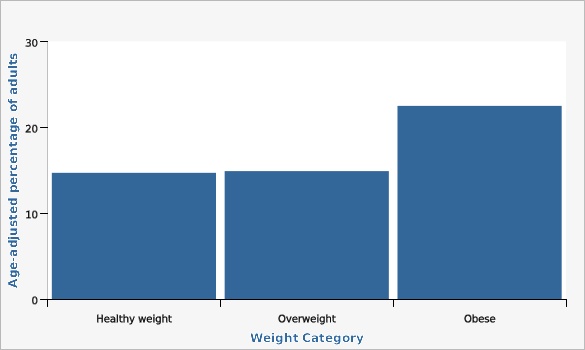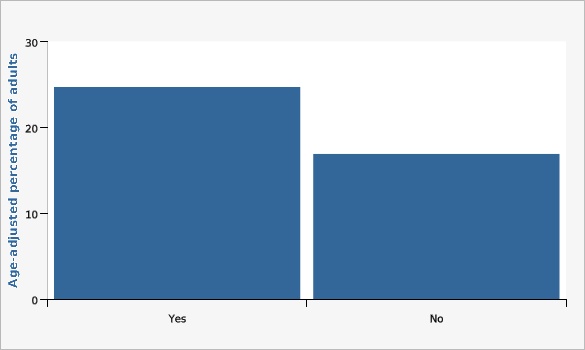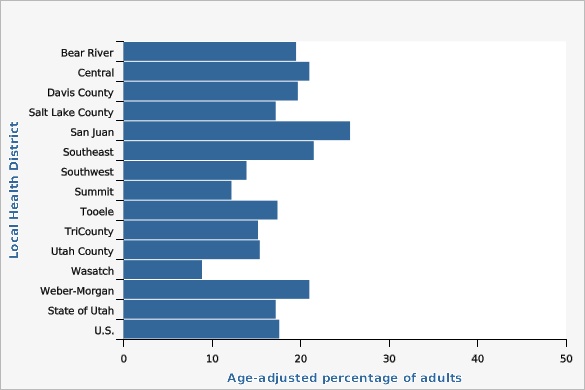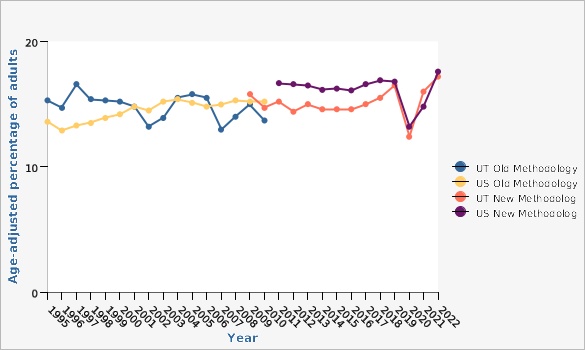Complete Health Indicator Report of Health Status: Physical Health Past 30 Days
Definition
Percentage of adults aged 18 years and older who reported seven or more days when their physical health was not good in the past 30 daysNumerator
Number of survey respondents who reported seven or more days when their physical health was not good in the past 30 daysDenominator
Total number of survey respondents excluding those with missing, "Don't know/Not sure" or "Refused" responsesData Interpretation Issues
Question Text: "Now thinking about your physical health, which includes physical illness and injury, for how many days during the past 30 days was your physical health NOT good?" Beginning in 2011, BRFSS data includes both landline and cell phone respondent data along with a new weighting methodology called iterative proportional fitting, or raking. This methodology utilizes additional demographic information (such as education, race, and marital status) in the weighting procedure. Both of these methodology changes were implemented to account for an increased number of U.S. households without landline phones and an under-representation of certain demographic groups that were not well-represented in the sample. More details about these changes can be found at: [https://ibis.health.utah.gov/pdf/opha/resource/brfss/RakingImpact2011.pdf]. As with all surveys, some error results from non-response (e.g., refusal to participate in the survey or to answer specific questions), and measurement (e.g., social desirability or recall bias). Error was minimized by the use of strict calling protocols, good questionnaire design, standardization of interviewer behavior, interviewer training, and frequent, on-site interviewer monitoring and supervision.Why Is This Important?
General physical health status is the culmination of all the things that affect a person's health. A person may have had poor health because of an injury, an acute infection such as a cold or flu, or a chronic health problem. This measure can be used to identify health disparities, track population trends, plan public health programs, and measure progress toward several Healthy People 2030 goals.Other Objectives
One of the Council of State and Territorial Epidemiologists (CSTE) Chronic Disease Indicators: "Average recent physically unhealthy days among adults."How Are We Doing?
In 2022, an estimated 17.2% (age-adjusted rate) of Utah adults reported seven or more days in the past 30 days when their physical health was not good. Adults who were obese reported seven or more days of poor physical health at higher rates (22.5%) than their normal weight (14.7%) or overweight (14.9%) counterparts (age-adjusted rates). Current smokers also reported higher rates of poor physical health (24.7%) in the past 30 days than nonsmokers (16.9%) (age-adjusted rates).How Do We Compare With the U.S.?
Looking at age-adjusted rates for 2022, Utah had only a slightly lower rate than the U.S. rate of adults who reported seven or more days when their physical health was not good in the past 30 days. Utah's rate was 17.2% and the U.S. rate was 17.6%. Age-adjusted rates were used to compare Utah and the U.S. because Utah has a younger population than the U.S., and younger adults are less likely to experience poor physical health than older adults. Age-adjusting controls for differences in this measure that are due to the difference in age distributions of the populations.What Is Being Done?
Until the last few years efforts to control chronic diseases have focused on preventing premature mortality. Reducing morbidity and improving disease self-management skills are now receiving considerably more attention from chronic disease prevention and control programs. The goal is to decrease the percentage of adults, including those who may have a chronic condition, who experience poor physical health days.Available Services
The Department of Health and Human Services' mission is to ensure all Utahns have fair and equitable opportunities to live safe and healthy lives. We will achieve this through effective policy and a seamless system of services and programs. Visit the Utah Department of Health and Human Services website at [https://dhhs.utah.gov/] for more information about public health services in Utah.Related Indicators
Relevant Population Characteristics
Health status is associated with age, education level, and household income. Older adults report more physical health problems than younger adults. College graduates and those with higher household incomes report the lowest number of unhealthy days.Related Relevant Population Characteristics Indicators:
Health Care System Factors
Because people often seek health care when they feel unhealthy, poor self-perceived health can be associated with burden on the health care delivery system.Related Health Care System Factors Indicators:
Risk Factors
Poor health status is related to many of the risk factors for disease and injury such as overweight/obesity, physical inactivity, smoking, and lack of immunization.Related Risk Factors Indicators:
Health Status Outcomes
Number of days when physical health is not good in the past 30 days is related to poor health outcomes like activity limitation, hospitalization, and death.Related Health Status Outcomes Indicators:
Graphical Data Views
| Males vs. Females | Age Group | Percentage of adults | Lower Limit | Upper Limit | ||
|---|---|---|---|---|---|---|
Record Count: 12 | ||||||
| Male | 18-34 | 10.1% | 8.3% | 12.3% | ||
| Male | 35-49 | 13.0% | 10.7% | 15.7% | ||
| Male | 50-64 | 13.5% | 11.2% | 16.2% | ||
| Male | 65+ | 22.7% | 19.8% | 25.9% | ||
| Female | 18-34 | 19.1% | 16.2% | 22.5% | ||
| Female | 35-49 | 18.8% | 16.2% | 21.7% | ||
| Female | 50-64 | 22.3% | 19.2% | 25.8% | ||
| Female | 65+ | 23.8% | 20.9% | 27.0% | ||
Data Source
Utah Department of Health and Human Services Behavioral Risk Factor Surveillance System (BRFSS) [https://ibis.health.utah.gov/ibisph-view/query/selection/brfss/BRFSSSelection.html]| Education Level | Age-adjusted percentage of adults 25+ | Lower Limit | Upper Limit | |||
|---|---|---|---|---|---|---|
Record Count: 5 | ||||||
| Less than high school | 28.6% | 23.3% | 34.7% | |||
| H.S. grad or G.E.D. | 19.5% | 17.3% | 22.0% | |||
| Some post high school | 19.0% | 17.1% | 21.0% | |||
| College graduate | 12.9% | 11.7% | 14.1% | |||
| Total | 17.7% | 16.7% | 18.8% | |||
Data Notes
Age-adjusted to the 2000 U.S. standard population.Data Source
Utah Department of Health and Human Services Behavioral Risk Factor Surveillance System (BRFSS) [https://ibis.health.utah.gov/ibisph-view/query/selection/brfss/BRFSSSelection.html]| Income Category | Age-adjusted percentage of adults | Lower Limit | Upper Limit | |||
|---|---|---|---|---|---|---|
Record Count: 6 | ||||||
| <$25,000 | 34.0% | 29.1% | 39.3% | |||
| $25,000-$49,999 | 20.5% | 18.0% | 23.3% | |||
| $50,000-$74,999 | 17.8% | 15.1% | 20.9% | |||
| $75,000+ | 13.8% | 12.4% | 15.4% | |||
| Total | 17.2% | 16.2% | 18.2% | |||
Data Notes
Age-adjusted to the 2000 U.S. standard population.Data Source
Utah Department of Health and Human Services Behavioral Risk Factor Surveillance System (BRFSS) [https://ibis.health.utah.gov/ibisph-view/query/selection/brfss/BRFSSSelection.html]| Hispanic Ethnicity | Age-adjusted percentage of adults | Lower Limit | Upper Limit | |||
|---|---|---|---|---|---|---|
Record Count: 4 | ||||||
| Hispanic/Latino | 19.6% | 16.6% | 23.0% | |||
| Non-Hispanic/Latino | 16.8% | 15.8% | 17.9% | |||
| All ethnicities | 17.2% | 16.2% | 18.2% | |||
| U.S. | 17.6% | 17.3% | 17.8% | |||
Data Notes
Age-adjusted to the 2000 U.S. standard population.Data Sources
- Utah Department of Health and Human Services Behavioral Risk Factor Surveillance System (BRFSS) [https://ibis.health.utah.gov/ibisph-view/query/selection/brfss/BRFSSSelection.html]
- Behavioral Risk Factor Surveillance System Survey Data, US Department of Health and Human Services Centers for Disease Control and Prevention (CDC).
Seven or more days of poor physical health in the past 30 days by race, Utah, 2020-2022 and U.S. 2022
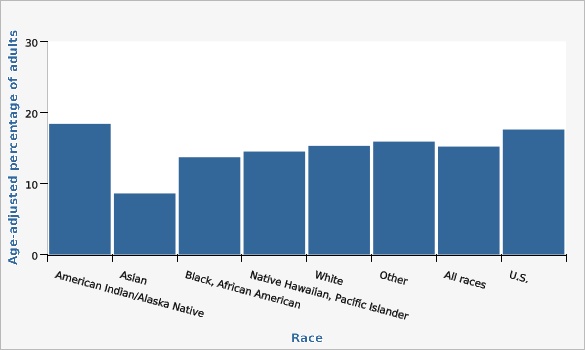
| Race | Age-adjusted percentage of adults | Lower Limit | Upper Limit | |||
|---|---|---|---|---|---|---|
Record Count: 8 | ||||||
| American Indian/Alaska Native | 18.4% | 14.2% | 23.5% | |||
| Asian | 8.6% | 6.1% | 12.0% | |||
| Black, African American | 13.7% | 9.9% | 18.5% | |||
| Native Hawaiian, Pacific Islander | 14.5% | 9.2% | 22.2% | |||
| White | 15.3% | 14.7% | 15.8% | |||
| Other | 15.9% | 13.7% | 18.4% | |||
| All races | 15.2% | 14.7% | 15.7% | |||
| U.S. | 17.6% | 17.3% | 17.8% | |||
Data Notes
Age adjusted to the U.S. 2000 standard population based on 3 age groups: 18-34, 35-49, and 50+.Data Sources
- Utah Department of Health and Human Services Behavioral Risk Factor Surveillance System (BRFSS) [https://ibis.health.utah.gov/ibisph-view/query/selection/brfss/BRFSSSelection.html]
- Behavioral Risk Factor Surveillance System Survey Data, US Department of Health and Human Services Centers for Disease Control and Prevention (CDC).
Adults who were obese reported seven or more days of poor physical health at higher rates (19.3%) than their normal weight (13.0%) or overweight (13.6%) counterparts.
| Weight Category | Age-adjusted percentage of adults | Lower Limit | Upper Limit | |||
|---|---|---|---|---|---|---|
Record Count: 3 | ||||||
| Healthy weight | 14.7% | 13.1% | 16.5% | |||
| Overweight | 14.9% | 13.2% | 16.7% | |||
| Obese | 22.5% | 20.4% | 24.8% | |||
Data Notes
Age-adjusted to the 2000 U.S. standard population. Body Mass Index (BMI) less than 25 is considered normal or ideal. BMI between 25 and 30 is considered overweight. BMI 30 or above is considered obese.Data Source
Utah Department of Health and Human Services Behavioral Risk Factor Surveillance System (BRFSS) [https://ibis.health.utah.gov/ibisph-view/query/selection/brfss/BRFSSSelection.html]Current current smokers reported higher rates of poor physical health (24.7%) in the past 30 days than nonsmokers (16.9%).
| Age-adjusted percentage of adults | Lower Limit | Upper Limit | ||||
|---|---|---|---|---|---|---|
Record Count: 2 | ||||||
| Yes | 24.7% | 20.3% | 29.6% | |||
| No | 16.9% | 15.8% | 17.9% | |||
Data Notes
Age-adjusted to the 2000 U.S. standard population.Data Source
Utah Department of Health and Human Services Behavioral Risk Factor Surveillance System (BRFSS) [https://ibis.health.utah.gov/ibisph-view/query/selection/brfss/BRFSSSelection.html]| Local Health District | Age-adjusted percentage of adults | Lower Limit | Upper Limit | Note | ||
|---|---|---|---|---|---|---|
Record Count: 15 | ||||||
| Bear River | 19.5% | 15.7% | 23.8% | |||
| Central | 21.0% | 16.3% | 26.6% | |||
| Davis County | 19.7% | 16.4% | 23.5% | |||
| Salt Lake County | 17.2% | 15.4% | 19.1% | |||
| San Juan | 25.6% | 13.9% | 42.2% | |||
| Southeast | 21.5% | 15.7% | 28.7% | |||
| Southwest | 13.9% | 11.0% | 17.5% | |||
| Summit | 12.2% | 6.5% | 21.6% | |||
| Tooele | 17.4% | 12.8% | 23.2% | |||
| TriCounty | 15.2% | 11.4% | 20.1% | |||
| Utah County | 15.4% | 13.5% | 17.5% | |||
| Wasatch | 8.9% | 5.0% | 15.4% | * | ||
| Weber-Morgan | 21.0% | 17.8% | 24.6% | |||
| State of Utah | 17.2% | 16.2% | 18.2% | |||
| U.S. | 17.6% | 17.3% | 17.8% | |||
Data Notes
Age-adjusted to the 2000 U.S. standard population. *Use caution in interpreting; the estimate has a coefficient of variation >30% and is therefore deemed unreliable by Utah Department of Health and Human Services standards.Data Sources
- Utah Department of Health and Human Services Behavioral Risk Factor Surveillance System (BRFSS) [https://ibis.health.utah.gov/ibisph-view/query/selection/brfss/BRFSSSelection.html]
- Behavioral Risk Factor Surveillance System Survey Data, US Department of Health and Human Services Centers for Disease Control and Prevention (CDC).
Seven or more days of poor physical health in the past 30 days by Utah Small Area, 2020-2022 and U.S. 2022
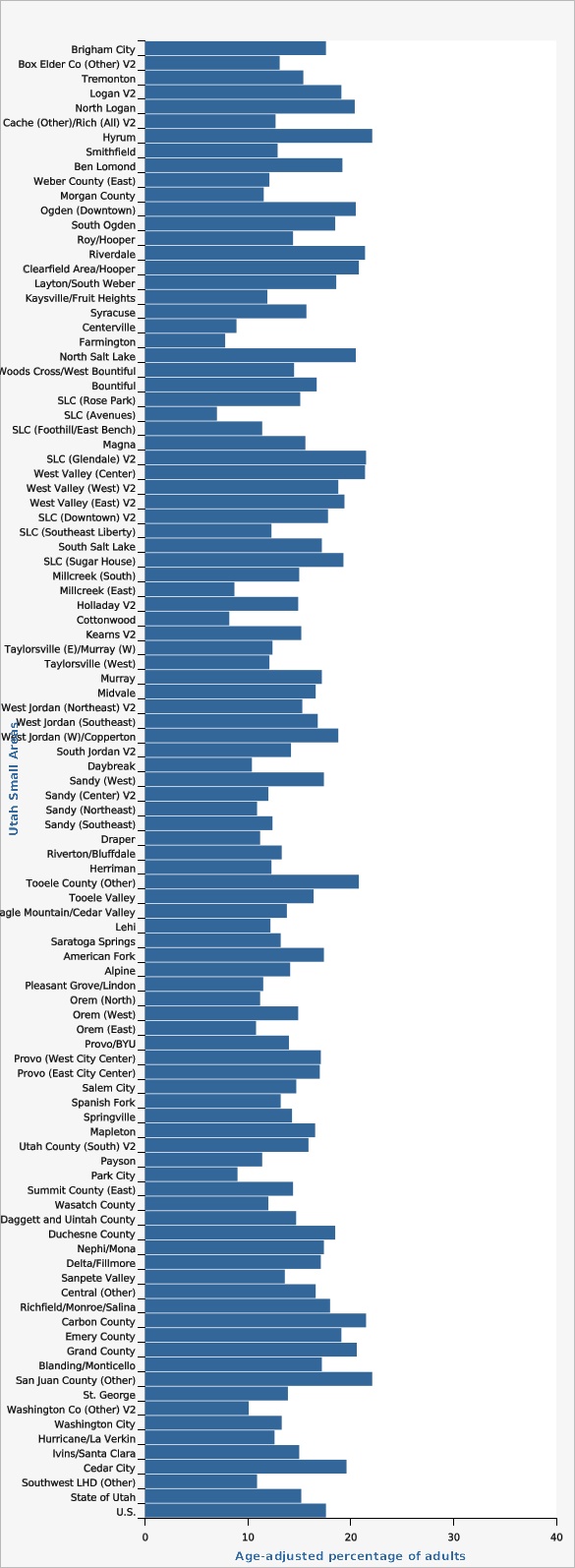
| Utah Small Areas | Age-adjusted percentage of adults | Lower Limit | Upper Limit | Note | ||
|---|---|---|---|---|---|---|
Record Count: 101 | ||||||
| Brigham City | 17.6% | 12.2% | 24.9% | |||
| Box Elder Co (Other) V2 | 13.1% | 7.4% | 22.1% | |||
| Tremonton | 15.4% | 9.8% | 23.3% | |||
| Logan V2 | 19.1% | 15.2% | 23.7% | |||
| North Logan | 20.4% | 14.6% | 27.8% | |||
| Cache (Other)/Rich (All) V2 | 12.7% | 8.6% | 18.5% | |||
| Hyrum | 22.1% | 13.7% | 33.5% | |||
| Smithfield | 12.9% | 7.7% | 20.8% | |||
| Ben Lomond | 19.2% | 15.5% | 23.7% | |||
| Weber County (East) | 12.1% | 8.6% | 16.7% | |||
| Morgan County | 11.5% | 5.7% | 22.0% | * | ||
| Ogden (Downtown) | 20.5% | 15.9% | 26.1% | |||
| South Ogden | 18.5% | 14.2% | 23.7% | |||
| Roy/Hooper | 14.4% | 10.6% | 19.2% | |||
| Riverdale | 21.4% | 15.3% | 29.1% | |||
| Clearfield Area/Hooper | 20.8% | 16.6% | 25.9% | |||
| Layton/South Weber | 18.6% | 15.0% | 22.9% | |||
| Kaysville/Fruit Heights | 11.9% | 8.1% | 17.1% | |||
| Syracuse | 15.7% | 10.9% | 22.1% | |||
| Centerville | 8.9% | 4.7% | 16.3% | |||
| Farmington | 7.8% | 4.4% | 13.6% | |||
| North Salt Lake | 20.5% | 12.9% | 31.0% | |||
| Woods Cross/West Bountiful | 14.5% | 9.2% | 22.2% | * | ||
| Bountiful | 16.7% | 12.9% | 21.4% | |||
| SLC (Rose Park) | 15.1% | 10.5% | 21.2% | |||
| SLC (Avenues) | 7.0% | 4.1% | 11.7% | |||
| SLC (Foothill/East Bench) | 11.4% | 6.8% | 18.5% | |||
| Magna | 15.6% | 10.9% | 21.8% | |||
| SLC (Glendale) V2 | 21.5% | 14.3% | 31.0% | |||
| West Valley (Center) | 21.4% | 16.4% | 27.6% | |||
| West Valley (West) V2 | 18.8% | 13.5% | 25.6% | |||
| West Valley (East) V2 | 19.4% | 15.0% | 24.8% | |||
| SLC (Downtown) V2 | 17.8% | 12.9% | 24.2% | |||
| SLC (Southeast Liberty) | 12.3% | 7.8% | 18.8% | |||
| South Salt Lake | 17.2% | 12.0% | 24.0% | |||
| SLC (Sugar House) | 19.3% | 14.3% | 25.5% | |||
| Millcreek (South) | 15.0% | 8.2% | 25.9% | |||
| Millcreek (East) | 8.7% | 5.3% | 14.1% | |||
| Holladay V2 | 14.9% | 9.3% | 23.2% | |||
| Cottonwood | 8.2% | 5.6% | 11.9% | |||
| Kearns V2 | 15.2% | 10.9% | 20.8% | |||
| Taylorsville (E)/Murray (W) | 12.4% | 8.8% | 17.2% | |||
| Taylorsville (West) | 12.1% | 8.5% | 17.1% | |||
| Murray | 17.2% | 12.6% | 23.2% | |||
| Midvale | 16.6% | 12.3% | 22.1% | |||
| West Jordan (Northeast) V2 | 15.3% | 10.7% | 21.4% | |||
| West Jordan (Southeast) | 16.8% | 12.3% | 22.7% | |||
| West Jordan (W)/Copperton | 18.8% | 13.8% | 25.2% | |||
| South Jordan V2 | 14.2% | 10.0% | 19.6% | |||
| Daybreak | 10.4% | 6.8% | 15.8% | |||
| Sandy (West) | 17.4% | 10.0% | 28.7% | |||
| Sandy (Center) V2 | 12.0% | 7.6% | 18.4% | |||
| Sandy (Northeast) | 10.9% | 6.2% | 18.6% | |||
| Sandy (Southeast) | 12.4% | 8.5% | 17.7% | |||
| Draper | 11.2% | 7.9% | 15.7% | |||
| Riverton/Bluffdale | 13.3% | 9.7% | 18.0% | |||
| Herriman | 12.3% | 8.6% | 17.4% | |||
| Tooele County (Other) | 20.8% | 14.8% | 28.4% | |||
| Tooele Valley | 16.4% | 13.4% | 19.8% | |||
| Eagle Mountain/Cedar Valley | 13.8% | 9.2% | 20.2% | |||
| Lehi | 12.2% | 9.5% | 15.5% | |||
| Saratoga Springs | 13.2% | 8.9% | 19.3% | |||
| American Fork | 17.4% | 13.4% | 22.3% | |||
| Alpine | 14.1% | 6.5% | 28.0% | * | ||
| Pleasant Grove/Lindon | 11.5% | 8.8% | 14.8% | |||
| Orem (North) | 11.2% | 8.0% | 15.3% | |||
| Orem (West) | 14.9% | 11.3% | 19.4% | |||
| Orem (East) | 10.8% | 7.0% | 16.3% | |||
| Provo/BYU | 14.0% | 10.0% | 19.4% | |||
| Provo (West City Center) | 17.1% | 12.4% | 23.1% | |||
| Provo (East City Center) | 17.0% | 10.4% | 26.4% | |||
| Salem City | 14.7% | 7.3% | 27.4% | * | ||
| Spanish Fork | 13.2% | 9.8% | 17.7% | |||
| Springville | 14.3% | 10.6% | 19.1% | |||
| Mapleton | 16.5% | 9.4% | 27.4% | * | ||
| Utah County (South) V2 | 15.9% | 10.1% | 24.3% | |||
| Payson | 11.4% | 7.8% | 16.3% | |||
| Park City | 9.0% | 5.7% | 14.0% | |||
| Summit County (East) | 14.4% | 8.8% | 22.7% | |||
| Wasatch County | 12.0% | 9.0% | 16.0% | |||
| Daggett and Uintah County | 14.7% | 11.9% | 18.0% | |||
| Duchesne County | 18.5% | 14.5% | 23.4% | |||
| Nephi/Mona | 17.4% | 10.8% | 26.8% | |||
| Delta/Fillmore | 17.1% | 10.9% | 25.8% | |||
| Sanpete Valley | 13.6% | 9.5% | 19.2% | |||
| Central (Other) | 16.6% | 12.5% | 21.7% | |||
| Richfield/Monroe/Salina | 18.0% | 13.0% | 24.5% | |||
| Carbon County | 21.5% | 17.2% | 26.5% | |||
| Emery County | 19.1% | 13.2% | 26.9% | |||
| Grand County | 20.6% | 13.7% | 29.9% | |||
| Blanding/Monticello | 17.2% | 11.3% | 25.3% | |||
| San Juan County (Other) | 22.1% | 13.7% | 33.8% | |||
| St. George | 13.9% | 11.0% | 17.4% | |||
| Washington Co (Other) V2 | 10.1% | 4.9% | 19.6% | * | ||
| Washington City | 13.3% | 8.3% | 20.7% | |||
| Hurricane/La Verkin | 12.6% | 8.3% | 18.5% | |||
| Ivins/Santa Clara | 15.0% | 8.0% | 26.3% | |||
| Cedar City | 19.6% | 15.0% | 25.3% | |||
| Southwest LHD (Other) | 10.9% | 8.0% | 14.8% | |||
| State of Utah | 15.2% | 14.7% | 15.8% | |||
| U.S. | 17.6% | 17.3% | 17.8% | |||
Data Notes
Age-adjusted to the 2000 U.S. standard population. *Use caution in interpreting; the estimate has a coefficient of variation >30% and is therefore deemed unreliable by Utah Department of Health and Human Services standards. A description of the Utah Small Areas may be found on IBIS at the following URL: [https://ibis.health.utah.gov/resource/Guidelines.html].Data Sources
- Utah Department of Health and Human Services Behavioral Risk Factor Surveillance System (BRFSS) [https://ibis.health.utah.gov/ibisph-view/query/selection/brfss/BRFSSSelection.html]
- Behavioral Risk Factor Surveillance System Survey Data, US Department of Health and Human Services Centers for Disease Control and Prevention (CDC).
| BRFSS Utah vs. U.S. | Year | Age-adjusted percentage of adults | Lower Limit | Upper Limit | Note | |
|---|---|---|---|---|---|---|
Record Count: 58 | ||||||
| UT Old Methodology | 1995 | 15.3% | 13.6% | 17.1% | ||
| UT Old Methodology | 1996 | 14.7% | 13.1% | 16.3% | ||
| UT Old Methodology | 1997 | 16.6% | 14.7% | 18.4% | ||
| UT Old Methodology | 1998 | 15.4% | 13.7% | 17.1% | ||
| UT Old Methodology | 1999 | 15.3% | 13.6% | 16.9% | ||
| UT Old Methodology | 2000 | 15.2% | 13.5% | 16.9% | ||
| UT Old Methodology | 2001 | 14.8% | 13.4% | 16.3% | ||
| UT Old Methodology | 2002 | 13.2% | 11.8% | 14.5% | ||
| UT Old Methodology | 2003 | 13.9% | 12.4% | 15.3% | ||
| UT Old Methodology | 2004 | 15.5% | 14.3% | 16.6% | ||
| UT Old Methodology | 2005 | 15.8% | 14.6% | 17.0% | ||
| UT Old Methodology | 2006 | 15.5% | 14.3% | 16.8% | ||
| UT Old Methodology | 2007 | 13.0% | 11.9% | 14.1% | ||
| UT Old Methodology | 2008 | 14.0% | 12.9% | 15.2% | ||
| UT Old Methodology | 2009 | 15.0% | 14.1% | 15.9% | ||
| UT Old Methodology | 2010 | 13.7% | 12.8% | 14.6% | ||
| US Old Methodology | 1995 | 13.6% | 13.3% | 14.0% | ||
| US Old Methodology | 1996 | 12.9% | 12.6% | 13.2% | ||
| US Old Methodology | 1997 | 13.3% | 13.0% | 13.6% | ||
| US Old Methodology | 1998 | 13.5% | 13.2% | 13.8% | ||
| US Old Methodology | 1999 | 13.9% | 13.6% | 14.2% | ||
| US Old Methodology | 2000 | 14.2% | 13.9% | 14.5% | ||
| US Old Methodology | 2001 | 14.8% | 14.6% | 15.1% | ||
| US Old Methodology | 2002 | 14.5% | 14.0% | 14.9% | ^ | |
| US Old Methodology | 2003 | 15.2% | 14.9% | 15.5% | ||
| US Old Methodology | 2004 | 15.4% | 15.1% | 15.7% | ||
| US Old Methodology | 2005 | 15.1% | 14.9% | 15.4% | ||
| US Old Methodology | 2006 | 14.8% | 14.6% | 15.1% | ||
| US Old Methodology | 2007 | 15.0% | 14.7% | 15.2% | ||
| US Old Methodology | 2008 | 15.3% | 15.0% | 15.5% | ||
| US Old Methodology | 2009 | 15.2% | 15.0% | 15.4% | ||
| US Old Methodology | 2010 | 15.2% | 15.0% | 15.4% | ||
| UT New Methodology | 2009 | 15.8% | 14.9% | 16.7% | ||
| UT New Methodology | 2010 | 14.7% | 13.9% | 15.5% | ||
| UT New Methodology | 2011 | 15.2% | 14.4% | 16.0% | ||
| UT New Methodology | 2012 | 14.4% | 13.7% | 15.2% | ||
| UT New Methodology | 2013 | 15.0% | 14.2% | 15.8% | ||
| UT New Methodology | 2014 | 14.6% | 14.0% | 15.3% | ||
| UT New Methodology | 2015 | 14.6% | 13.8% | 15.4% | ||
| UT New Methodology | 2016 | 14.6% | 13.7% | 15.5% | ||
| UT New Methodology | 2017 | 15.0% | 14.1% | 15.9% | ||
| UT New Methodology | 2018 | 15.5% | 14.7% | 16.4% | ||
| UT New Methodology | 2019 | 16.5% | 15.7% | 17.4% | ||
| UT New Methodology | 2020 | 12.4% | 11.6% | 13.4% | ||
| UT New Methodology | 2021 | 16.0% | 15.1% | 16.9% | ||
| UT New Methodology | 2022 | 17.2% | 16.2% | 18.2% | ||
| US New Methodology | 2011 | 16.7% | 16.5% | 16.9% | ||
| US New Methodology | 2012 | 16.6% | 16.3% | 16.8% | ||
| US New Methodology | 2013 | 16.5% | 16.3% | 16.7% | ||
| US New Methodology | 2014 | 16.1% | 15.9% | 16.4% | ||
| US New Methodology | 2015 | 16.2% | 16.1% | 16.5% | ||
| US New Methodology | 2016 | 16.1% | 15.8% | 16.3% | ||
| US New Methodology | 2017 | 16.6% | 16.4% | 16.8% | ||
| US New Methodology | 2018 | 16.9% | 16.7% | 17.2% | ||
| US New Methodology | 2019 | 16.8% | 16.6% | 17.0% | ||
| US New Methodology | 2020 | 13.2% | 12.9% | 13.4% | ||
| US New Methodology | 2021 | 14.8% | 14.5% | 15.0% | ||
| US New Methodology | 2022 | 17.6% | 17.3% | 17.8% | ||
Data Notes
Age adjusted to U.S. 2000 standard population. ^ In 2002, only Utah and 22 other states asked the question. U.S. data are the average for all states and the District of Columbia; they do not include the U.S. territories. Note: At the time of this update, the BRFSS U.S. dataset did not include an age variable but did include five age categories up to age 80+ (vs. the typical weighting scheme that includes 85+). Comparisons with both weighting schemes were compared using Utah data, and the difference was about 1/100 of a percentage point. Starting in 2009, the BRFSS included both landline and cell phone respondent interviews along with a new weighting methodology called iterative proportional fitting, or raking. More details about these changes can be found at: [https://ibis.health.utah.gov/pdf/opha/resource/brfss/RakingImpact2011.pdf].Data Sources
- Utah Department of Health and Human Services Behavioral Risk Factor Surveillance System (BRFSS) [https://ibis.health.utah.gov/ibisph-view/query/selection/brfss/BRFSSSelection.html]
- Behavioral Risk Factor Surveillance System Survey Data, US Department of Health and Human Services Centers for Disease Control and Prevention (CDC).
References and Community Resources
Centers for Disease Control and Prevention: [http://www.cdc.gov] MedlinePlus: MedlinePlus brings together authoritative information for the general public from the National Library of Medicine, the National Institutes of Health (NIH), and other government agencies and health-related organizations. [http://medlineplus.gov/] More information on the Behavioral Risk Factor Surveillance System may be found on the website of the Centers for Disease Control and Prevention - [http://www.cdc.gov/brfss/]More Resources and Links
Evidence-based community health improvement ideas and interventions may be found at the following sites:- Centers for Disease Control and Prevention (CDC) WONDER Database, a system for disseminating public health data and information.
- United States Census Bureau data dashboard.
- Utah healthy Places Index, evidence-based and peer-reviewed tool, supports efforts to prioritize equitable community investments, develop critical programs and policies across the state, and much more.
- County Health Rankings
- Kaiser Family Foundation's StateHealthFacts.org
- Medical literature can be queried at PubMed library.
Page Content Updated On 03/07/2024,
Published on 04/17/2024

